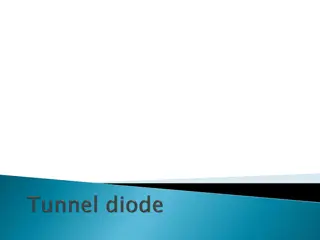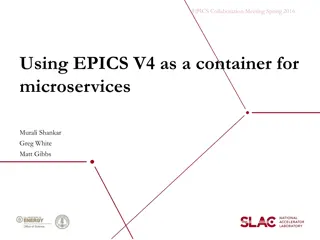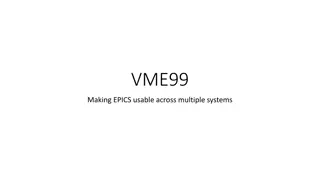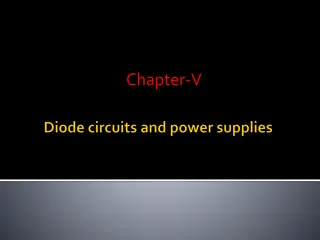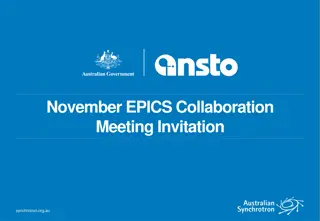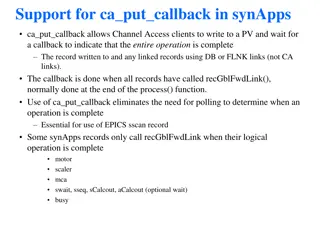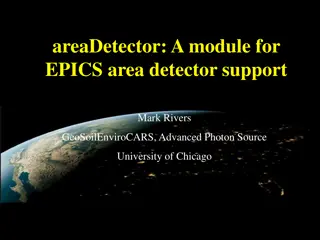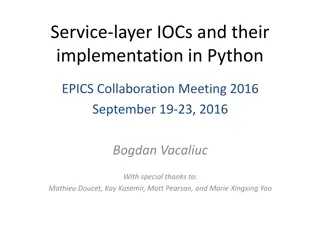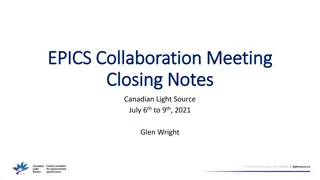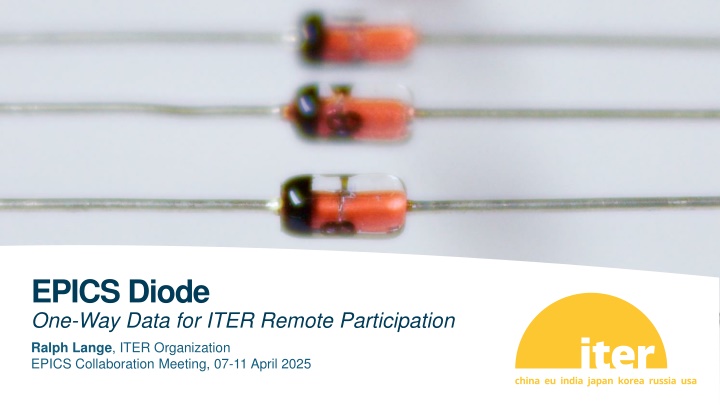
EPICS Diode Data Transfer for ITER Remote Participation
"Learn about the uni-directional live data extraction system EPICS Diode used for ITER remote participation. Explore the requirements, background, and implementation details of this one-way UDP protocol for transferring data in the context of nuclear research and plant controls."
Uploaded on | 0 Views
Download Presentation

Please find below an Image/Link to download the presentation.
The content on the website is provided AS IS for your information and personal use only. It may not be sold, licensed, or shared on other websites without obtaining consent from the author. If you encounter any issues during the download, it is possible that the publisher has removed the file from their server.
You are allowed to download the files provided on this website for personal or commercial use, subject to the condition that they are used lawfully. All files are the property of their respective owners.
The content on the website is provided AS IS for your information and personal use only. It may not be sold, licensed, or shared on other websites without obtaining consent from the author.
E N D
Presentation Transcript
EPICS Diode One-Way Data for ITER Remote Participation Ralph Lange, ITER Organization EPICS Collaboration Meeting, 07-11 April 2025
ITER Remote Participation Scope 1) Plant Operators: local access from plant network (POZ, IEC 62645 S2) using control system (CODAC) tools 2) Experimentalists: access from experiment preparation and analysis network (XPOZ, S3) using CODAC tools in read-only mode. Could be both local and remote 3) Occasional Users: remote access from office network / internet (S4) using web / remote desktop tools Network zone extension to a remote site is done using a VPN (zones S1 / S2 require on-site presence) Focus in this talk on uni-directional live data extraction EPICS Diode 2 Ralph Lange 07 Apr 2025
Background Don t reinvent the wheel, just realign it. F4E (Giuseppe Ferro et al.) developed an EPICS Data Diode (presented at the EPICS Collaboration Meeting in 2020). Their implementation uses HTTP on the long distance. I&C security audit by Thales in 2020 recommended getting rid of EPICS gateways on plant network boundary in favor of indirect access via live databases or archives. If propagation delay would be too high, a diode- like solution was recommended. Anthony D Angelo ITER (Leonid Lobes) has tested CA working fine over long distance (presented at the EPICS Collaboration Meeting in 2022), meaning propagation of EPICS traffic could be a viable option for ITER remote centers. Nuclear licensing in France could result in severe limitations on live data exposure, so ITER decided to make another implementation of a diode using a strictly uni-directional protocol (one-way UDP). This would also mean freedom from vendor-lock, as most commercial diodes support UDP out of the box (but none support EPICS). EPICS Diode 3 Ralph Lange 07 Apr 2025
Requirements One-way UDP 50.000 simple PVs per instance @ 10 Hz update Support of CA (V1) and PVA (V2) Propagation delay 100 ms Detection of stale connection (dead sender) Only value updates are transferred; DB (re-)configuration is considered as maintenance action not in scope No modification of source IOCs and servers (if possible) Can be turned on / off without impact on plant controls High integrity coding for sender (plant) side EPICS Diode 4 Ralph Lange 07 Apr 2025
Replicating an IOC Using a UDP Stream (version 0) Both sides (sender and receiver) are fully configured. Sender has CA subscriptions and sends updates (value/time/status) through a mostly binary UDP streaming protocol. Receiver Device Support reads data into the EPICS Database. The setup is local, with CA being used locally or across the long distance. The setup is local, with CA being used locally or across the long distance. Replicating an IOC Using a UDP Stream (version 0) Both sides (sender and receiver) are fully configured. Sender has CA subscriptions and sends updates (value/time/status) through a mostly binary UDP streaming protocol. Receiver Device Support reads data into the EPICS Database.
Replicated Records Replicating an IOC Using a UDP Stream (version 1) Both sides (sender and receiver) are fully configured. Sender has CA subscriptions and sends updates (value/time/status) through a mostly binary UDP streaming protocol. Receiver pushes data into the EPICS Database and sends out CA updates. Replicating an IOC Using a UDP Stream (version 1) Both sides (sender and receiver) are fully configured. Sender has CA subscriptions and sends updates (value/time/status) through a mostly binary UDP streaming protocol. Receiver pushes data into the EPICS Database and sends out CA updates. The setup is local, with CA being used locally or across the long distance. The setup is local, with CA being used locally or across the long distance.
Configuration and Startup Both sender and receiver are configured using the same JSON file. IOC shell integration (receiver): # Configure records read-only asSetFilename("$(DIODE_ROOT)/cfg/readOnly.acf") { // Minimum sender update period in seconds. (min = 0.025) "min_update_period": 0.025, // Polled fields update period in seconds. (min = 3.0) "polled_fields_update_period": 5.0, // Heartbeat period in seconds. (min = 0.1) "heartbeat_period": 15.0, // Maximum sender sent rate in MB/s, 0 for no limit. "rate_limit_mbs": 64, // Array of channels to export (order matters!). "channel_names": { "MSC:T-0":{}, "MSC:T-1":{}, ... } } # Load DBD dbLoadDatabase("$(DIODE_ROOT)/dbd/testDiode.dbd") testDiode_registerRecordDeviceDriver(pdbbase) # Trace = 0, Debug = 1, Config = 2, Info = 3 (default), # Warning = 4, Error = 5 diodeLogLevel(3) # Load DB dbLoadRecords("$(DIODE_ROOT)/db/db_test_2000.db") # Start the receiver thread with the listening port & IP diodeReceiverStart("$(DIODE_ROOT)/cfg/diode.json", 5080, "10.130.1.102") # Start the IOC diodeIocInit() EPICS Diode 7 Ralph Lange 07 Apr 2025
IOC Databases Outside (optional markup of records with a non-standard sequence number): Inside (no modification of existing records): record(calc, "MSC:T-0") { field(CALC, "B?0:val+1") field(SCAN, "0") field(FLNK, "MSC:T-1") field(INPB, "MSC:RESET") } record(calc, "MSC:T-0") { field(CALC, "B?0:val+1") field(SCAN, "0") field(FLNK, "MSC:T-1") field(INPB, "MSC:RESET") } record(calc, "MSC:T-1") { info(diode_cix, "1") field(CALC, "B?0:val+1") field(SCAN, "Passive") field(FLNK, "MSC:T-2") field(INPB, "MSC:RESET") } record(calc, "MSC:T-1") { field(CALC, "B?0:val+1") field(SCAN, "Passive") field(FLNK, "MSC:T-2") field(INPB, "MSC:RESET") } ... ... A diode_dbgen tool could be used to query the IOC on the inside and produce a DB file for the IOC on the outside. The info field diode_cix is only required if the name of the PV on the outside is different from the one inside / in the config. EPICS Diode 8 Ralph Lange 07 Apr 2025
Sender Integration in ITER CODAC Environment $ sudo systemctl start codac-7.1-epics-diode-poz@10.130.1.102 $ sudo systemctl status codac-7.1-epics-diode-poz@10.130.1.102 codac-7.1-epics-diode-poz@10.130.1.102.service Loaded: loaded (/usr/lib/systemd/system/codac-7.1-epics-diode-poz@.service; disabled; vendor preset: enabled) Active: active (running) since Wed 2024-09-11 06:58:03 UTC; 9s ago Main PID: 120690 (diode_sender) Tasks: 6 (limit: 49463) Memory: 2.3M CGroup: /system.slice/system-codac\x2d7.1\x2depics\x2ddiode\x2dpoz.slice/codac-7.1-epics-diode-poz@10.130.1.102.service 120690 /opt/codac-7.1/apps/epics-diode/bin/diode_sender -c /opt/codac-7.1/apps/epics-diode/cfg/diode.json 10.130.1.102 Sep 11 06:58:03 4504ds-srv-0029.codac.iter.org systemd[1]: Started codac-7.1-epics-diode-poz@10.130.1.102.service. Sep 11 06:58:03 4504ds-srv-0029.codac.iter.org diode_sender[120690]: 2024-09-11T06:58:03.398 [config] Loading configuration from '/opt/codac-7.1/apps/epics-diode/cfg/diode.json'. Sep 11 06:58:03 4504ds-srv-0029.codac.iter.org diode_sender[120690]: 2024-09-11T06:58:03.399 [sender] Initializing transport, send list: [10.130.1.102:5080]. Sep 11 06:58:03 4504ds-srv-0029.codac.iter.org diode_sender[120690]: 2024-09-11T06:58:03.399 [sender] Initializing CA. Sep 11 06:58:03 4504ds-srv-0029.codac.iter.org diode_sender[120690]: 2024-09-11T06:58:03.399 [sender] Creating 2000 channels. EPICS Diode 9 Ralph Lange 07 Apr 2025
Network Tuning Best performance requires significantly increasing network buffers and packet sides on both parts of the diode: # Receiver side $ sudo sysctl -w net.core.rmem_default=26214400 $ sudo sysctl -w net.core.rmem_max=26214400 # Sender side $ sudo sysctl -w net.core.wmem_default=26214400 $ sudo sysctl -w net.core.wmem_max=26214400 # Both sides $ sudo ifconfig eth0 mtu 9000 EPICS Diode 10 Ralph Lange 07 Apr 2025
Performance Test Configuration Reference: CA EPICS Source IOC EPICS Client Software Diode: CA UDP CA EPICS Source IOC EPICS Diode INT EPICS Diode EXT EPICS Client Hardware Diode: UDP CA CA EPICS Source IOC EPICS Diode INT EPICS Diode EXT EPICS Client Hardware data diode EPICS Diode 11 Ralph Lange 07 Apr 2025
Hardware Diode Test Stand + two client virtual machines with EPICS software diode (not shown) External network (RX) Internal network (TX) Diode host INT Diode host EXT Uni-directional fiber connection Waterfall WF-500. 1 Gbps UDP. Embedded hosts available as option Hardware Diode EPICS Diode 12 Ralph Lange 07 Apr 2025
Propagation Delay Test: 2.000 PV at 10 Hz (Graph) Direct reading: Time (s) With a software diode: With a hardware diode: EPICS Diode 13 Ralph Lange 07 Apr 2025
Propagation Delay Test: 2.000 PV at 10 Hz (Tabular) Software Diode Direct reading: With a software diode: Time , min , Avg 2024-09-09 07:30:35.006, 0.00222794, 0.0147023, 0.028491 2024-09-09 07:30:40.009, 0.00225168, 0.0156245, 0.0433001 2024-09-09 07:30:45.012, 0.00226114, 0.0148075, 0.0335019 2024-09-09 07:30:50.016, 0.00224274, 0.0153224, 0.0549977 2024-09-09 07:30:55.029, 0.00224464, 0.0148566, 0.0317156 2024-09-09 07:31:00.037, 0.00223602, 0.0149802, 0.0363677 2024-09-09 07:31:05.044, 0.00219899, 0.0148636, 0.0307716 2024-09-09 07:31:10.056, 0.00225856, 0.0150708, 0.0370319 2024-09-09 07:31:15.065, 0.0022554, 0.0150547, 0.039358 2024-09-09 07:31:20.071, 0.00224622, 0.0151776, 0.0396417 2024-09-09 07:31:25.077, 0.00225115, 0.0150516, 0.036602 2024-09-09 07:31:30.084, 0.00226824, 0.0151594, 0.0429711 2024-09-09 07:31:35.090, 0.00224812, 0.0148512, 0.0294496 2024-09-09 07:31:40.095, 0.00223143, 0.0148588, 0.0363419 2024-09-09 07:31:45.101, 0.00225451, 0.0153008, 0.04302 2024-09-09 07:31:50.105, 0.00225747, 0.0153995, 0.0392186 2024-09-09 07:31:55.110, 0.00227762, 0.0149405, 0.0326959 2024-09-09 07:32:00.116, 0.00224443, 0.0153642, 0.0444384 2024-09-09 07:32:05.125, 0.00224313, 0.0149166, 0.0394424 2024-09-09 07:32:10.133, 0.00228578, 0.0153907, 0.0412106 2024-09-09 07:32:15.138, 0.00230542, 0.0152157, 0.0410428 2024-09-09 07:32:20.143, 0.00228728, 0.014978, 0.0369561 2024-09-09 07:32:25.149, 0.00228458, 0.0153488, 0.0322483 , max Time , min , Avg 2024-09-06 07:23:08.958, 0.00523455, 0.0291069, 0.0563685 2024-09-06 07:23:13.962, 0.00329676, 0.0304606, 0.0552727 2024-09-06 07:23:18.965, 0.00398524, 0.029149, 0.0702227 2024-09-06 07:23:23.969, 0.00452183, 0.0290567, 0.0611334 2024-09-06 07:23:28.974, 0.00464556, 0.0299505, 0.0539586 2024-09-06 07:23:33.977, 0.00454899, 0.0307251, 0.0610959 2024-09-06 07:23:38.980, 0.00396552, 0.0329809, 0.0668529 2024-09-06 07:23:43.984, 0.00385853, 0.0299367, 0.0778222 2024-09-06 07:23:48.987, 0.00357364, 0.0316497, 0.0646217 2024-09-06 07:23:53.993, 0.00360718, 0.0293324, 0.0529508 2024-09-06 07:23:58.996, 0.00402128, 0.0294285, 0.0548909 2024-09-06 07:24:04.000, 0.00401748, 0.0296965, 0.0547798 2024-09-06 07:24:09.012, 0.0038931, 0.0311468, 0.0755579 2024-09-06 07:24:14.019, 0.00433052, 0.0296455, 0.0576727 2024-09-06 07:24:19.022, 0.00357776, 0.0296013, 0.0561386 2024-09-06 07:24:24.026, 0.00382108, 0.0301167, 0.0580669 2024-09-06 07:24:29.031, 0.00401149, 0.0290561, 0.0591794 2024-09-06 07:24:34.037, 0.00471695, 0.0314323, 0.0618587 2024-09-06 07:24:39.046, 0.00329788, 0.0288512, 0.0552057 2024-09-06 07:24:44.050, 0.00455049, 0.0318294, 0.0596405 2024-09-06 07:24:49.054, 0.00343947, 0.0289353, 0.0975649 2024-09-06 07:24:54.058, 0.00383182, 0.0308581, 0.0673679 2024-09-06 07:24:59.062, 0.00405254, 0.0300098, 0.0547065 , max Avg Difference Avg 0.004042 0.029911 0.060481 0.002339 0.015223 0.039427 0.001704 0.014688 0.021054 (seconds) Latency ~ 15 ms = Requirement met. 2024-09-09 08:29:28.234, 0.0023682, 0.0155377, 0.0367443 2024-09-06 08:21:57.066, 0.00340158, 0.0253352, 0.0548381 EPICS Diode 14 Ralph Lange 07 Apr 2025
Propagation Delay Test: 2.000 PV at 10 Hz (Tabular) Hardware Diode Direct reading: With a hardware diode: In 5 s window Time , min , Avg 2024-09-09 07:30:35.006, 0.00222794, 0.0147023, 0.028491 2024-09-09 07:30:40.009, 0.00225168, 0.0156245, 0.0433001 2024-09-09 07:30:45.012, 0.00226114, 0.0148075, 0.0335019 2024-09-09 07:30:50.016, 0.00224274, 0.0153224, 0.0549977 2024-09-09 07:30:55.029, 0.00224464, 0.0148566, 0.0317156 2024-09-09 07:31:00.037, 0.00223602, 0.0149802, 0.0363677 2024-09-09 07:31:05.044, 0.00219899, 0.0148636, 0.0307716 2024-09-09 07:31:10.056, 0.00225856, 0.0150708, 0.0370319 2024-09-09 07:31:15.065, 0.0022554, 0.0150547, 0.039358 2024-09-09 07:31:20.071, 0.00224622, 0.0151776, 0.0396417 2024-09-09 07:31:25.077, 0.00225115, 0.0150516, 0.036602 2024-09-09 07:31:30.084, 0.00226824, 0.0151594, 0.0429711 2024-09-09 07:31:35.090, 0.00224812, 0.0148512, 0.0294496 2024-09-09 07:31:40.095, 0.00223143, 0.0148588, 0.0363419 2024-09-09 07:31:45.101, 0.00225451, 0.0153008, 0.04302 2024-09-09 07:31:50.105, 0.00225747, 0.0153995, 0.0392186 2024-09-09 07:31:55.110, 0.00227762, 0.0149405, 0.0326959 2024-09-09 07:32:00.116, 0.00224443, 0.0153642, 0.0444384 2024-09-09 07:32:05.125, 0.00224313, 0.0149166, 0.0394424 2024-09-09 07:32:10.133, 0.00228578, 0.0153907, 0.0412106 2024-09-09 07:32:15.138, 0.00230542, 0.0152157, 0.0410428 2024-09-09 07:32:20.143, 0.00228728, 0.014978, 0.0369561 2024-09-09 07:32:25.149, 0.00228458, 0.0153488, 0.0322483 , max Time , min , Avg 2024-09-13 08:15:03.128, 0.00490939, 0.0313841, 0.0538449 2024-09-13 08:15:08.131, 0.00425254, 0.0320064, 0.0862429 2024-09-13 08:15:13.135, 0.00559753, 0.0318712, 0.0642206 2024-09-13 08:15:18.139, 0.00548258, 0.0318799, 0.0598045 2024-09-13 08:15:23.142, 0.00568218, 0.0325599, 0.0746377 2024-09-13 08:15:28.146, 0.00423283, 0.0335971, 0.0636418 2024-09-13 08:15:33.149, 0.00636099, 0.0299653, 0.0644183 2024-09-13 08:15:38.153, 0.00472146, 0.0333809, 0.0601963 2024-09-13 08:15:43.156, 0.00473473, 0.031251, 0.0635979 2024-09-13 08:15:48.160, 0.00470414, 0.0337608, 0.0581836 2024-09-13 08:15:53.163, 0.00664546, 0.0308281, 0.0940041 2024-09-13 08:15:58.167, 0.00433338, 0.0331315, 0.0591587 2024-09-13 08:16:03.170, 0.00487864, 0.0305319, 0.062216 2024-09-13 08:16:08.173, 0.00479006, 0.0335254, 0.057082 2024-09-13 08:16:13.177, 0.00603843, 0.0300104, 0.0598382 2024-09-13 08:16:18.181, 0.00476638, 0.033446, 0.0622389 2024-09-13 08:16:23.184, 0.00504441, 0.0302326, 0.0665274 2024-09-13 08:16:28.187, 0.0043991, 0.031836, 0.0594936 2024-09-13 08:16:33.191, 0.0053994, 0.0318103, 0.0547522 2024-09-13 08:16:38.195, 0.00459638, 0.0316021, 0.0592841 2024-09-13 08:16:43.201, 0.00556159, 0.0319331, 0.0685137 2024-09-13 08:16:48.204, 0.00418333, 0.0322342, 0.0559437 , max avg Difference avg 0.002339 0.015223 0.039427 0.002882 0.016797 0.023306 0.00522 0.03202 0.06273 (seconds) Latency ~ 17 ms = Requirement met. 2024-09-13 09:14:55.779, 0.00499899, 0.0299252, 0.0539671 2024-09-09 08:29:28.234, 0.0023682, 0.0155377, 0.0367443 EPICS Diode 15 Ralph Lange 07 Apr 2025
Losses above 2.000 PV @ 10 Hz = Requirement not met. PV Loss Test: 10 Hz Updates over 24 h Software Diode N of PV lost in the event Datetime 4.000 PV @ 10Hz 3.000 PV @ 10Hz 2.000 PV @ 10Hz 2024-08-28 14:34:20, START 2024-08-28 16:26:27, 2046 2024-08-28 20:41:29, 2046 2024-08-29 00:12:20, 2046 2024-08-29 01:31:12, 2046 2024-08-29 13:17:18, 2046 2024-08-29 14:34:21, END 2024-09-05 15:18:26, START 2024-09-06 15:18:27, END 2024-09-04 12:45:27, START 2024-09-04 19:52:37, 2046 2024-09-05 00:56:50, 2046 2024-09-05 01:17:21, 2046 2024-09-05 02:45:36, 2046 2024-09-05 11:05:50, 3000 2024-09-05 12:08:28, 2046 2024-09-05 12:45:28, END No losses Few losses Few losses Moderate losses ( 5%) between 5.000 and 10.000 PVs, severe losses (> 15%) above 10.000 PVs. The rare glitch around 2046 PVs to be understood UDP configuration issue or diode software issue? Reason found: 2046 PVs = 1 UDP packet, we experience packet reordering in our virtualization platform, fix in progress EPICS Diode 16 Ralph Lange 07 Apr 2025
Internal PVA Server PVA PVA Internal PVA Server PVA PVXS PVXS PVA PVA Internal PVA Server Replicating PVA Using a UDP Stream (prototype of version 2) Both sides (sender and receiver) are fully configured. Sender has PVA subscriptions and sends updates through a mostly binary UDP streaming protocol. Receiver sends out PVA updates. The setup is local, with PVA being used locally and across the long distance.
Status and Roadmap Requirements and Design Documents are approved. V1.0 supporting CA (record) PVs delivered by our contractor (Cosylab) in April 2024 and independently verified. User manual prepared. Operation over hardware diode confirmed. Prototype of V2.0 supporting PVA (structured) PVs has been delivered. No production use is foreseen yet because ITER plant commissioning does not require this level of security. There are no ITER specifics in the code. It will be made available to the EPICS collaboration. (The ITER Publication of Software process has been started.) Stay tuned for future reports on this. Credits Denis Stepanov, Leonid Lobes (ITER) Matej Sekoranja (Cosylab) Thank you! EPICS Diode 18 Ralph Lange 07 Apr 2025

